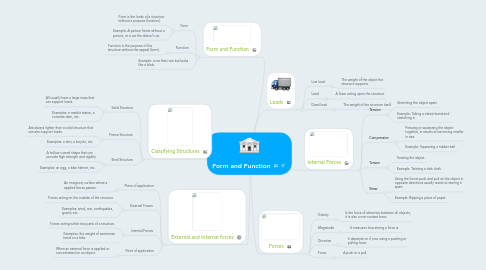
1. External and Internal forces
1.1. Plane of application
1.1.1. An imaginary surface where a applied forces passes.
1.2. External Forces
1.2.1. Forces acting on the outside of the structure.
1.2.2. Examples: wind, rain, earthquakes, gravity etc.
1.3. Internal Forces
1.3.1. Forces acting within two parts of a structure.
1.3.2. Examples: the weight of someones hand on a bike.
1.4. Point of application
1.4.1. When an external force is applied or concentrated on an object.
2. Classifying Structures
2.1. Solid Structure
2.1.1. All usually have a large mass that can support loads.
2.1.2. Examples: a marble statue, a concrete dam, etc.
2.2. Frame Structure
2.2.1. Are always lighter then a solid structure that can also support loads.
2.2.2. Examples: a tent, a bicycle, etc
2.3. Shell Structure
2.3.1. A hollow curved shape that can provide high strength and rigidity.
2.3.2. Examples: an egg, a bike helmet, etc.
3. Form and Function
3.1. Form
3.1.1. Form is the looks of a structure without a purpose (function).
3.1.2. Example: A picture frame without a picture, or a car the doesn't run.
3.2. Function
3.2.1. Function is the purpose of the structure without the appeal (form).
3.3. Example: a car that runs but looks like a blob.
4. Loads
4.1. Live load
4.1.1. The weight of the object the structure supports.
4.2. Load
4.2.1. A force acting upon the structure.
4.3. Dead load
4.3.1. The weight of the structure itself.
5. Forces
5.1. Gravity
5.1.1. Is the force of attraction between all objects, it is also a non-contact force.
5.2. Magnitude
5.2.1. It measures how strong a force is.
5.3. Dircetion
5.3.1. It depends on if your using a pushing or pulling force.
5.4. Force
5.4.1. A push or a pull.
6. Internal Forces
6.1. Tension
6.1.1. Stretching the object apart.
6.1.2. Example: Taking a elastic-band and stretching it.
6.2. Compression
6.2.1. Pressing or squeezing the object together, in results to becoming smaller in size.
6.2.2. Example: Squeezing a rubber ball.
6.3. Torsion
6.3.1. Twisting the object.
6.3.2. Example: Twisting a dish cloth.
6.4. Shear
6.4.1. Using the forces push and pull on the object in opposite directions usually reacts to tearing it apart.
6.4.2. Example: Ripping a piece of paper.

